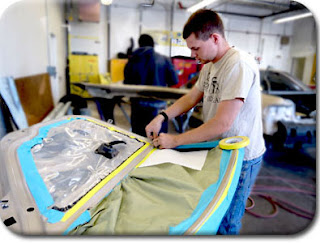We drive to school. We drive to work. We drive back home. We do it again the next day, everyday. Many of us take driving for granted that we don't realize how much sun exposure is damaging our car's paint job. Luckily, there's a way to refinish and fix the outer appearance of your car.
Students from the Auto Body Program at the Maricopa Skill Center demonstrate how to do a solid paint job in auto body refinishing.
 |
| Auto Body garage at Maricopa Skill Center. |
Students remove and disassemble all parts to a car. After they are all taken down, students use soap and wax grease remover to clean all parts.
 |
| All parts and panels removed from a '03 Chevy Malibu. |
Once all the parts are cleaned, a 40-Grit Sandpaper is used to strip down the paint. An 80-Grit Sandpaper is then used to take out all rusted areas. Once the rusted areas are smoothed out it is ready for masking application.
 |
| Clayton Cluff masks a door panel before applying primer. |
Yellow tape is used for masking, which helps prevent paint from bleeding underneath. After all areas are carefully masked, the next step is to apply Etch primer.
Primer
Etch primer and primer is then applied to give the best protection to the metal. After the primer dries, wet sanding is done to help the paint adhere to the metal.
Paint
The next step is to reassemble all the parts and panels back together. The car is then driven to the paint booth where students spray base coat. After the base coat dries, three coats of the original paint are sprayed. After a few days of drying, three coats of clear are then sprayed.
Buff
After the clear coats dry, wet sanding is done again to sand out any other imperfections of the paint job. The car is then buffed and polished.
 |
| Manuel Ortiz buffs the hood of a '93 Honda Prelude. |
Stay tuned for next week's program spotlight: Health Care!











